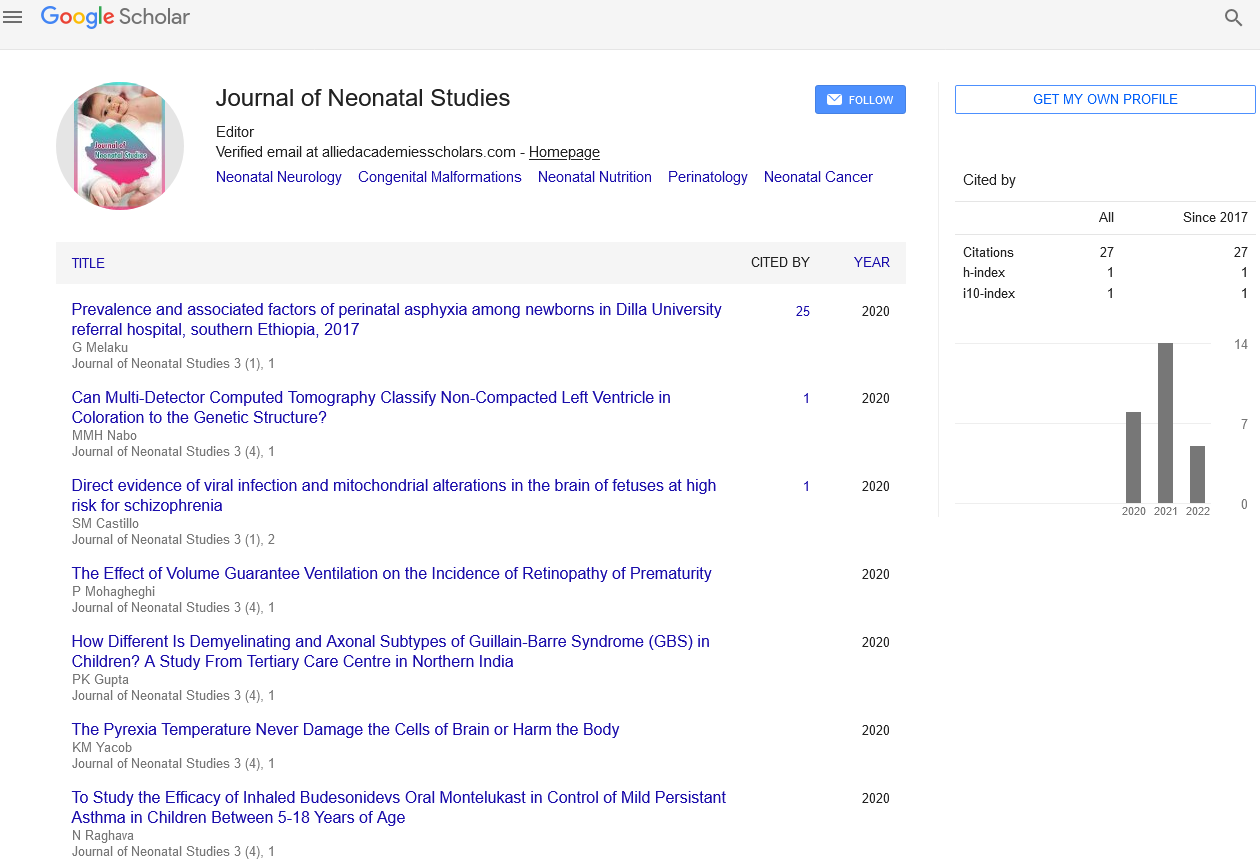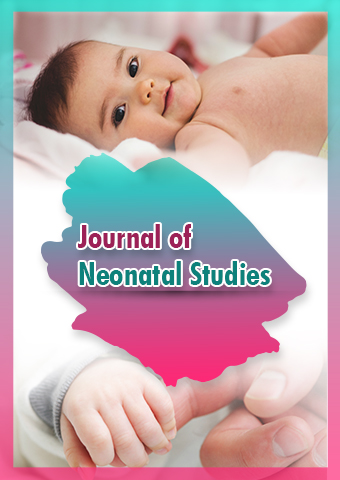Short Article - Journal of Neonatal Studies (2018) Volume 1, Issue 2
Binge drinking practice among university students in northern region of Brazil
Andre Tomaz Terra, Carlos Eduardo Martinelli and Luiz Antonio Del Ciampo
University of São Paulo, Brazil
Abstract
Keywords: Ethanol – Alcoholism - Alcoholic intoxication – Binge drinking
Introduction: More than two billion people worldwide are regular alcohol users making it the most widely used recreational drug, particularly among university students, representing a serious public health problem1 . In recent decades, a new type of alcohol consumption has been observed among adolescents and young adults, called “binge drinking” (BD), which is characterized by the ingestion of a large amount of alcohol on the same occasion (four or more doses for women and five or more doses for men or 80 mg/dL of alcohol in the adult individual) 2 . This practice is considered a risk behavior due to the possibility of causing anatomical and functional alterations in the central nervous system, especially in the prefrontal region and limbic system, culminating in negative repercussions on memory, cognitive and executive functions, as well as impairing inhibitory control of the individual3 . Also, the consumption of large amounts of alcohol can cause repercussions throughout the body, increasing the possibility of cardiocirculatory events (hypertension, stroke, myocardial infarction, and arrhythmias), gastric ulcers, pancreatitis, and impaired immune system, among others4 .
The aim of this study was to verify the prevalence of alcohol consumption and the practice of BD among university students from a higher education institution located in northern region of Brazil.
Material and Methods: This is a cross-sectional and observational study which was conducted with 518 university students from a private educational institution located in northern region of Brazil. All participants were provided via the online research tool indicated for the study, which is the Alcohol, Smoking and Substance Involvement Screening Test (ASSIST), a questionnaire prepared by the World Health Organization that contains questions related to the consumption of alcohol and eight other classes of psychoactive substances. For the characterization of BD the following definition of the National Institute on Alcohol and Alcoholism was adopted: intake that raises the blood alcohol concentration to 0.08 d/dL, which is equivalent to four or more doses for women and five or more doses for men over a twohour period4 . Exclusion criteria were defined as not completing the questionnaire and requesting the participant.
Data were analyzed using the Statistical Package for Social Science program (SPSS 17). Univariate analysis was performed to describe quantitative variables and bivariate analysis to verify the association between alcohol use and independent variables (gender, age), adopting a significance level of 5%.
Results: Among the 518 individuals, with a mean age of 23.1 years, 355 (68.5%) female and 163 (31.5%) male. Of these 518, 385 (74.3%) reported that they drink alcohol. Among the 385 who drink, 282 (73.2%) started before age 18 and 293 (76.1%) practice BD. Among the 293 BD practitioners, 122 (41.6%) less than once a month, 78 (26.6%) once a month, 35 (11.9%) once a week and, 4 (1, 3%) almost daily.
Discussion: Although the sale of alcoholic beverages to people under 18 years of age is prohibited in Brazil, alcohol consumption among adolescents is a common practice, following a worldwide trend5. In addition to the high prevalence (74.3%) of consumption among university students, 282 (54.4%) stated that they had had their first contact with alcohol before the age of 18.
Among the 385 students that reported consuming alcohol, the study identified 239 (62%) BD practitioners. This result follows the high prevalence found by other authors in studies conducted in the United States4 and in several European countries5,6. When analyzing the frequency which they practice BD it was found that 122 (51%) do it less than once a month and 39 (16.3%) at least once a week, which makes this a very worrying reality due the possibilities of negative physical, emotional and social consequences for these individuals and for the whole society that also suffers the repercussions caused by the high consumption of alcoholic beverages3 . In the population sample studied it was observed that the practice of BD occurred more among women (69%), which has also been verified in other studies4,7. Therefore, the greater severity of the problem stands out, since women, due to physiological and metabolic conditions, are more vulnerable to the effects of alcohol, suffering more physical and emotional consequences8.
The early initiation of alcohol consumption is considered a predisposing factor for chronic consumption throughout life, contributing to the development of physical and emotional problems, because in this age group, due to the great sensitivity of the developing central nervous system, the damage they can be large and definitive8 . Studies on the profile of BD practitioners have observed that they are uninhibited and impulsive individuals, seeking new challenges and emotions, with little capacity for inhibitory control and low risk perception, who end up underestimating the consequences of their attitudes3,4,8-10. Characteristics such as living alone or away from the family, having an independent life, being in higher education, not working full time and later marriage can also contribute to this practice5 . Knowledge about excessive alcohol consumption is important at the individual and collective levels, as this practice is associated with damage to health and well-being and can also predispose to addiction and its consequences as physical, emotional, and behavioral problems.
Some limitations should be pointed out, such as the possibility of underestimated responses and the small number of participants circumscribed to a region, not representative of the universe of Brazilian university students. However, the results allow us to conclude that there are patterns of alcohol consumption among these students that can trigger more serious problems. It also highlights the contribution of the study to the dissemination and reflection on this theme, confirming the importance of epidemiological analyzes that can support strategies for the promotion and prevention of health education, enabling the establishment of public policies aimed at protecting the physical and emotional health of the community.
References
- Moreau ME, Peterson J, L’Insalata A. Predictors of quickly progressing from initiating alcohol use to engaging in binge drinking among adolescents. Addict Behav Rep 2019;9:1-9.
- National Institute of Alcohol Abuse and Alcoholism (2004). NIAAA Council Approves Definition of Binge Drinking. NIAAA Newsletter, 3. Available online at: http://pubs.niaaa.nih.gov/publications/Newsletter/winter2004/Newsletter_ Number3.pdf.
- Lannoy S, Billieux J, Poncin M, Maurage P. Binging at the campus: motivations and impulsivity influence binge drinking profiles in university students. Psychiatry Res 2017;250:146-54.
- Lannoy S, Billieux J, Poncin M, Maurage P. Binging at the campus: motivations and impulsivity influence binge drinking profiles in university students. Psychiatry Res 2017;250:146-54.
- Lorant V, Nicaise P. Binge drinking at university: a social network study in Belgium. Health Prom Int 2014;30:675-82.
- Poikolainen K. Does the tail wag the dog? Abstainers, alcohol dependence, heavy episodic drinkers, and total alcohol consumption. Alcohol Alcoholism 2017;52:80-3.
- Tavolacci MP, Boerg E, Richard L, Meyrignac G, Dechelotte P, Ladner J. Prevalence of binge drinking and associated behaviours among 3286 college students in France. BMC Public Health 2016;16:178-83.
- López-Caneda E, Cadaveira F, Campanella S. Binge drinking in the adolescent and youg brain. Front Psychol 2019;9:1-4.
- Dormal V, Bremhorst V, Lannoy S, Lorant V, Luquiens A, Maurage P. Binge drinking is associated with reduced quality of life in young students: a pan-European study. DrugAlcoholDep2018;193:48-54.
- Kuntsche E, Kuntsche S, Thrul J, Gmel G. Binge drinking: Health impact, prevalence, correlates, and interventions. Psychol Health. 2017;32:976-1017.

